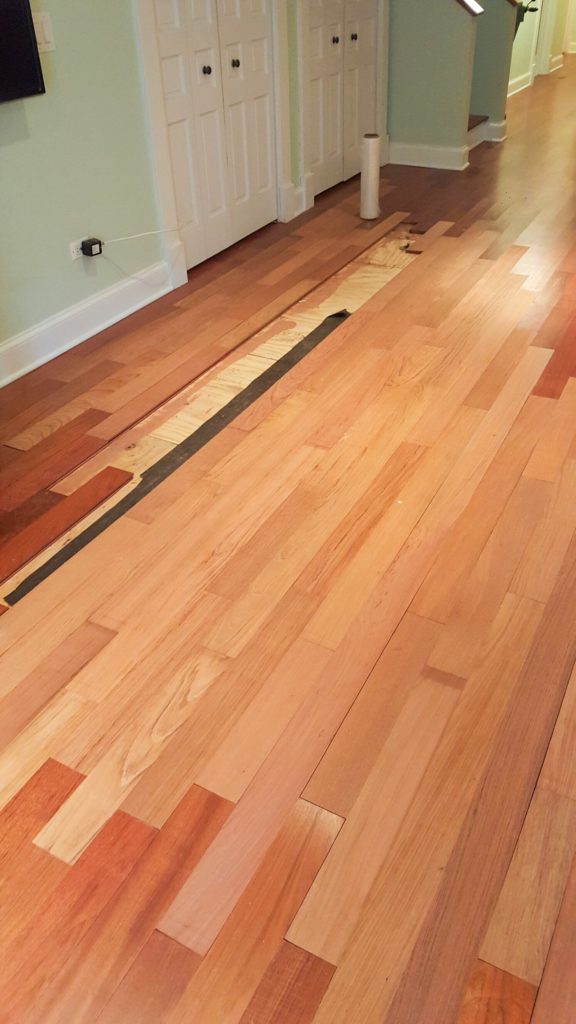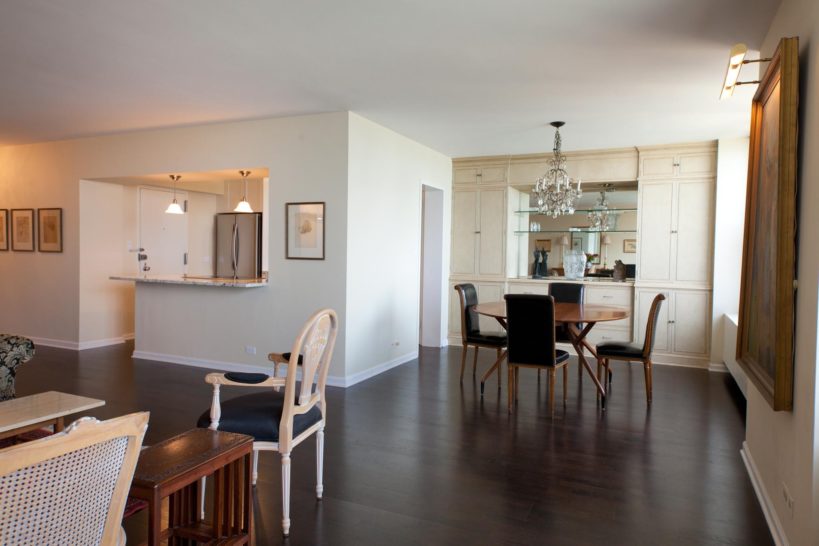Refinishing, Renovation, Repairs
Spot Refinishing Your Wood Floor Why We Won’t Do It
If there’s a single type of call that we receive most often from homeowners it is a call about worn spots in front of high traffic areas – refrigerator, sink, range, or desk. They’re asking how much it will cost to spot refinish just a portion of their hardwood or engineered wood floor.
Believe me. We understand that there’s nothing more frustrating than seeing a dark, dirty wear spot in front of the kitchen sink while the rest of the kitchen floor looks just fine. The fact of the matter is that uneven wear will always occur in high traffic areas unless you use protective mats and carpets.
So, why is it that we won’t do a spot refinishing of your floor? There are two primary reasons. First, it is impossible to match the newly sanded wood to the existing finished wood without sanding the entire floor. Second, it is virtually impossible to match the color and sheen of the old polyurethane with the new poly floor coating.
Unprotected Wood Floor Color Changes With Sanding, Sunlight and Staining

If your wood floor finish has worn away in high traffic areas, you’ll no doubt notice that the underlying wood is darker than the flooring with the good finish. The reason the unprotected wood is darker is that dirt and stains can be absorbed into the top layer of the wood, changing its color. To remove the staining and to ensure proper adhesion of a new coat of polyurethane, you have to sand off at least a 16th of an inch of the exposed wood. You also must sand away any remaining polyurethane in the corners and less trafficked areas so that the entire expanse of wood, when sanding is complete, looks exactly the same. This is the only way to guarantee an even edge-to-edge appearance for your floor.
Something else to remember is that if your floor has been exposed to sunlight on a regular basis, the grain and top color of the wood will be faded from the sun. Even the most perfectly applied layer of polyurethane won’t protect a sun-drenched floor from this inevitable bleaching process.
If you tried to spot sand and refinish only one area in sun-lit room, and then coated the spot with the exact same finish as the rest of the floor, the results would still look different because the underlying wood color in the area exposed to the sun would look remarkably different from the freshly sanded area.
Matching the Color and Sheen of the Polyurethane Is Not Possible
While you might not think that clear polyurethane has a color, it actually does! Mind you, it’s going to be a variation that may take a discerning eye to capture, but differences definitely exist and are noticeable – especially if you’re a perfectionist like Mr. Floor! What will be noticeable to everyone, however, will be the difference in the sheen of the freshly applied polyurethane with the older, existing poly coating.
Whether you choose a glossy or matte finish, with wear and time whatever the original finish sheen (gloss, semi-gloss, matte) will change as the floor is traveled and cleaned. A high gloss finish will dull over time as microscopic scratches wear down the lustrous, virgin coating. Much like the finish on a car, scratches knock down the shine.
Conversely, a non-reflective matte finish starts to pick up some shine, especially in highly traveled areas. When a matte finish is applied, there’s a microscopic layer of peaks and valleys that reflect light away from your eye, creating a flat appearance. As you walk on and clean the polyurethane topcoat, some of these microscopic peaks and valleys are worn flat, creating what will be a shinier path wherever people travel.
So, if you spot refinish a floor, whether matte, gloss or somewhere in between, you are definitely going to notice that the area just refinished has a different sheen than the older floor surrounding it.
Blending in Old and Newly-Finished Flooring is Virtually Impossible
When you try to just refinish a small portion of a floor, there’s no natural stopping point, like the end of a room or hallway. As a result, the refinished “patch” looks like, well, a patch! Second, the newest polyurethanes can’t be buffed which makes it impossible to blend in one section with another.
What If I Can’t Afford to Refinish My Whole Floor?
At Mr. Floor we’re flooring perfectionists. It would drive any of us nuts to see a patch job we did where the wood color was different, the finish different, and the sheen different. We wouldn’t be able to sleep!
There are times, however, when we could imagine that finances or living circumstances prohibit a whole floor being sanded and refinished. If that’s your situation, here’s our best advice.
First, if you think you can take the task on, make it a DIY project. Google “spot refinish a hardwood floor” and find a set of instructions that’s not filled with ads – the sure sign of click bait with little real knowledge. If you’ve got a random orbital sander and a shop vacuum that can attach to the sander, you can probably scuff the floor safely enough to allow two coats of poly to adhere. You’ll need to have some painting skills to put the finish on evenly and you won’t be able to walk on the area for two to three days minimum. This requires planning, especially in high traffic areas in front of a fridge or desk.
If you’re not a DIY’er, then you might be able to find someone working out of their van with some modest floor refinishing skills that will help you for a price. We normally wouldn’t come close to making this recommendation, but it will likely be the cheapest half-solution to the problem. You’ll still end up with a compromised floor finish, but if you can’t afford to do a full refinishing job, this might be the best temporary solution. Buyer beware!
Have questions? Email us at customer.service@mrfloor.com
Igor Murokh
Igor is a graduate of the University of Illinois and holds a B.A. in Economics. He has worked in the flooring industry for over 30 years and is the VP and Sales Manager of Mr. Floor Companies in Skokie, IL. Igor is a certified wood flooring inspector (CWFI) and routinely helps clients assess flooring issues.

